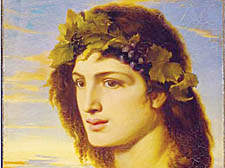|
|
 |
| |

Bacchus, 1867 |
Solomon comes out of the closet
A great artist ruined by Victorian hypocrisy gains his first exhibition for 100 years, writes Peter Gruner
IT is hard to avoid feeling intense anger and pity for the plight of Victorian Pre-Raphaelite artist Simeon Solomon, whose life was ruined at the height of his powers by an act of indecency in a public toilet.
There is pity at Solomon’s rapid fall from success and acclaim to ignominy and destitution following his arrest in the Paris lavatory in February 1873, aged 32. He was charged with indecent exposure and “attempting to commit sodomy”.
Now a new exhibition in Camden unveils Solomon’s paintings, many of which have not been on public display since the 1860s and 1870s.
In his lifetime the “love that dare not speak its name” was acceptable as long as men kept quiet about it.
You weep for Solomon, a nice Jewish boy who had a studio in Fitzroy Square.
His story begins in Bishopsgate, where he was born into an observant Jewish family in 1840. His elder bother Abraham and sister Rebecca were enjoying some success as artists and Simeon showed precocious talent. In 1856, aged just 15, Solomon entered the Royal Academy schools to pursue an artistic career himself.
He quickly enjoyed success with his paintings of Old Testament scenes, Jewish ritual and classical subjects.
Taking inspiration from his cultural heritage, one of Solomon’s most popular portraits is Shadrach, Meshach and Abednego, painted in 1863 and representing the three young male Hebrew heroes from the Old Testament huddling up together after being saved from a fiery furnace by an angel.
He soon became a popular figure within the Pre-Raphaelite circle of artists, writers and aesthetes including Rossetti and Swinburne, who enjoyed his company and admired his work.
One of his contemporaries, Sir William Blake Richmond, thought there was something of the mystic about Solomon and described him thus: “A fair little Hebrew, a Jew of Jews, who seemed to have inherited a great spirit, an Eastern of the Eastern, facile and spasmodically intense, sensitive to extreme touchiness… but he convulsed his friends to laughter by his strange weird imagination.”
With his reputation as the bad boy of the movement, Solomon’s male figures were quite often seen as obviously effete and dandy looking. They really upset Victorian society, which liked its men to look manly. The artist was doing for the semi-nude male form what Rossetti was doing for the female. Solomon was using lots of classical Greek male figures to indicate homo-erotic imagery. An example is his highly erotic Babylon Hath Been a Golden Cup (1859).
Following his conviction he was imprisoned for three months, and was subsequently ostracised from the artistic fraternity, the Jewish community and society as a whole. It became almost impossible for him to exhibit his art publicly and increasingly difficult for him to sell his work. Growing poverty, an unwillingness to depend on the charity of family and friends, who were still prepared to support him, and an increasing dependence on alcohol led him to a life of beggary and illness on the streets.
The last years of his life were spent in a where he continued to practise as an artist, producing deeply personal drawings charged with mystical and visionary intensity.
He died in the workhouse in 1905 and is buried in the Willesden Jewish cemetery. The exhibition, organised by the Birmingham Museums and Art Gallery, covers Solomon’s entire career, including his later works after his arrest and disgrace in 1873.
Marking the centenary of Solomon’s death, the exhibition enables the art world today, in recognition of his work, to put him in context.
Colin Cruise, who co-curated this exhibition, is a former senior lecturer in Art History at the University of Staffordshire and is now a freelance curator and writer. He has published widely on the Pre-Raphaelites and the Aesthetic Movement and is the Chair of the Association of Art.
Mr Cruise said: “The exhibition demonstrates Solomon’s re-emergence as a significant figure within the Pre-Raphaelite circle and late 19th century British art, and uncovers his powerful and original talent. Astonishingly this is the first major exhibition of Solomon in London since 1906.”
CLICK BELOW TO SERACH FOR ACCOMODATION
|
| |
|
 |
|